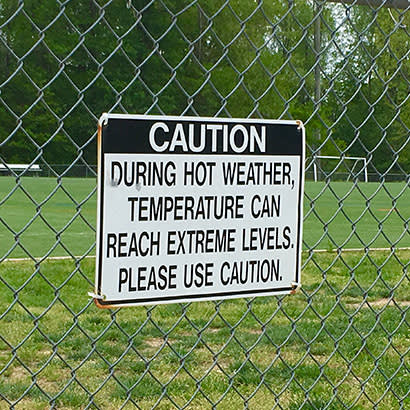
Synthetic turf fields are commonplace in many U.S. communities. According to the Synthetic Turf Council, there are “between 12,000 and 13,000 synthetic turf sports fields in the U.S., with approximately 1,200–1,500 new installations each year. If you’ve ever attended any game played on one of these fields on a hot, sunny day, you’ve probably seen the shimmer of heat rising from the surface or heard players complain about feeling the heat through their shoes.
Debate continues over the health impacts from playing on synthetic turf fields, but the high surface-level temperatures recorded on these fields compared to natural turf have been well-documented. Since grass leaves release water vapor (or transpire) and the evaporation of that water vapor leads to cooling, grass fields rarely get above 100° F. Turf fields, in comparison, regularly rise well above 100° F. Penn State University’s Center for Sports Surface Research conducted studies comparing surface temperatures of synthetic turfs composed of various fiber and infill colors/materials and found that the maximum surface temperatures during hot, sunny conditions averaged from 140° F to 170° F.
Another study conducted at Brigham Young University found that “The surface temperature of the synthetic turf was 37° F higher than asphalt and 86.5° F hotter than natural turf.” And, as neuroscientist Kathleen Michels points out: “Any temperature over 120° F can cause skin burns with skin contact in two seconds.”
Synthetic turf fields are advantageous for their all-weather utility, zero recovery time under heavy use and low (not “no”) maintenance, and product manufacturers have been working to find alternative infill materials that would generate lower surface-level temperatures. However, temperatures are on the rise across the globe, leading to seemingly longer, hotter periods — in mid-March this year, Mashable reported that “Alaska saw its earliest ever 70-degree Fahrenheit temperature” — and more and more parents are becoming increasingly concerned about their children playing on these fields on hot days. So, what can be done to try to lower the temperature for individuals, particularly children, who, the Penn State Center for Sports Surface Research points out, “are less able to adapt to changes in temperature”?
What Can Be Done?
The high surface-level temperatures on synthetic fields can lead to dehydration, burns and blisters if exposed skin comes into contact with the hot surface, as well as heat stroke. One of the first steps to take is to have someone regularly monitor the temperature levels at the surface of the sports field when it’s scheduled for use, particularly on hot days. It’s also helpful to post signs to alert parents and players to avoid using the field during times of high heat. Many park and rec agencies and school systems, like New York City Parks and Montgomery County Public Schools (MCPS) in Maryland, are already on board with this recommendation put forth by the Safe Healthy Playing Fields Coalition. MCPS developed the following heat guidelines that apply to and are posted at all its artificial turf fields:
- Anytime the outdoor temperature exceeds 80 degrees, coaches exercise caution in conducting activities on artificial turf fields.
- When outdoor temperatures exceed 90 degrees, coaches may hold one regular morning or evening practice (before noon or after 5 p.m.).
- When the heat index is between 91–104 degrees between the hours of noon and 5 p.m., school athletic activities are restricted on artificial turf fields to one hour, with water breaks every 20 minutes.
For the safety of their players, athletic departments at many colleges and universities schedule practices either in the early morning or late evening to avoid peak high-temperature times. The Synthetic Turf Council also recommends that “practices and events on synthetic turf fields be scheduled for cooler hours of the morning or evening during high- temperature summer months, that activities be limited in duration and intensity and that athletes be especially well-hydrated and regularly given breaks.”
Penn State’s Center for Sports Surface Research lists the following conditions under which synthetic surfaces get hot:
- Sunny/Clear
- Low humidity
- No clouds
- Noon – 3 p.m.
If playing on a hot synthetic turf field is unavoidable, Penn State’s Center for Sports Surface Research notes that heavy watering before the game can help reduce surface temperature, but it cautions that this is only effective for a short period of time. Temperatures rebound after only about 20 minutes (less time than it takes to play a regulation half game of soccer). Adding irrigation to, even watering, this type of sports field could cost thousands of dollars and, depending on the type of infill used, be ineffective, as water could simply roll off the surface and not really soak in to provide that small window of temperature relief. As a result, this may not be as cost effective or as safe as scheduling games around peak high-heat times.
Moving Forward
As previously mentioned, synthetic turf sports fields are appealing because, outside of weather conditions that include lightning, they can be used year-round and during inclement weather and are seen as being low maintenance. Both perceptions are debatable (the latter could be the basis of another article) — the former because as we encounter longer, more frequent periods of extreme heat (leading to more “code red” or “code orange” days) more “sunny” days will fall into the “inclement weather” category. As we enter into the summer months, it’s important to keep in mind that as durable as turf fields are, they still require maintenance and oversight to be used under safe conditions, especially during the heat of summer. The solutions may vary depending on local areas’ needs, but the desire to find solutions for safe conditions for all to enjoy summer sports is universal.
Sonia Myrick is the Executive Editor for Parks & Recreation magazine.

